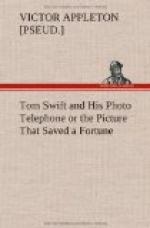“You see I’ve got to get evidence that will stand in the courts to convict this fellow, and if he’s scared off before we get that, the game will be up.”
“That’s what my photo telephone will do—it will get the evidence, just as a dictaphone does. In fact, I’m thinking of working it out on those lines, after I clear up this business.”
“Just suppose we had detectives stationed at all the telephones near the sawmill, where this fellow would be likely to go. In the first place no one has seen him, as far as we know, so there’s no telling what sort of a chap he is. And you can’t go up to a perfect stranger and arrest him because you think he is the man who has spirited away Mr. Damon.”
“Another thing. Until this fellow has talked, and made his offer to Mrs. Damon, to restore her husband, in exchange for certain papers, we have no hold over him.”
“But he has done that, Tom. You heard him, and you have his voice down on the wax cylinder.”
“Yes, but I haven’t had a glimpse of his face. That’s what I want, and what I’m going to get. Suppose he does go into the telephone booth, and tell Mrs. Damon an address where she is to send the papers. Even if a detective was near at hand he might not catch what was said. Or, if he did, on what ground could he arrest a man who, very likely, would be a perfect stranger to him? The detective couldn’t say: ’I take you into custody for telephoning an address to Mrs. Damon.’ That, in itself, is no crime.”
“No, I suppose not,” admitted Ned. “You’ve got this all thought out, Tom.”
“I hope I have. You see it takes quite a combination to get evidence against a criminal—evidence that will convict him. That’s why I have to be so careful in setting my trap.”
“I see, Tom. Well, it’s about time for us to get busy; isn’t it?”
“It sure is. There’s lots to do. First we’ll go see the telephone people.”
Tom explained to the ’phone manager the necessity for what he was about to do. The manager at once agreed to let the young inventor have a free hand. He was much interested in the photo telephone, and Tom promised to give his company a chance to use it on their lines, later.
The telephone near the sawmill was easily located. It was in a general store, and the instrument was in a booth. To this instrument Tom attached his sending plate, and he also substituted for the ordinary incandescent light, a powerful tungsten one, that would give illumination enough to cause the likeness to be transmitted over the wire.
The same thing was done to a number of the public telephones in that vicinity, each one being fitted up so that the picture of whoever talked would be transmitted over the wire when Tom turned the switch. To help the plan further the telephone manager marked a number of other ’phones, “Out of Order,” for the time being.
“Now, I think we’re done!” exclaimed the young inventor, with a sigh, late that night. He and Ned and the line manager had worked hard.




